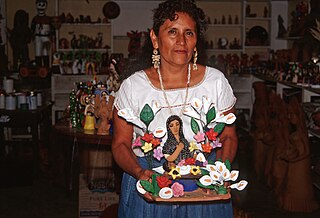Related Research Articles
Emilio Molinero Hurtado was a Mexican potter, noted for his revival of pre Hispanic pottery designs.
Maximo Gómez Ponce is a noted Mexican potter from the La Luz neighborhood of the city of Puebla, an area known for its local traditional pottery.

The Aguilar family of Ocotlán de Morelos are from a rural town in the state of Oaxaca, Mexico. This town produced only utilitarian items until Isaura Alcantara Diaz began creating decorative figures with her husband Jesus Aguila Revilla. The couple taught their five daughters who continued innovating their own styles and then teaching the two generations after them. Two of the sisters, Guilliermina and Irene have been named “grand masters” by the Fomento Cultural Banamex, for their figures and sets of figures related to the life and traditions of Oaxaca, as well as Mexican icons such as Frida Kahlo and the Virgin of Guadalupe. The younger generations have made their own adaptations with some attaining their own recognition such as Lorenzo Demetrio García Aguilar and Jose Francisco Garcia Vazquez.

María Lilia Calam Que is a Mexican potter from Tepakán, Campeche in southern Mexico, who specializes in water storage containers called cántaros. Her hometown was known for the making of these vessels but she is one of a handful of potters left who makes them, along with Teodora Cajúm, Claudia Pech Chi, Justina Kan and Rosalía Pan.
María de Jesús Nolasco Elías was a Mexican potter from Ocumicho, Michoacán, a town noted for the creation of colorful ceramic figurines.
Margarita Cruz Sipuach is a Mexican potter from Guachochi, Chihuahua. She learned pottery from her mother, Filomena Sipuachi. Today, she creates various kinds of utilitarian and ceremonial wares, but her specialty is a type of pot called “tesgüineras.” In 2001, she was named a “grand master” by the Fomento Cultural Banamex.
Cesar Torres Ramírez is a Mexican potter who specialized in the country Talavera pottery tradition. His work has been featured in books such as Cerámica Y Cultura: The Story of Spanish and Mexican Mayólica of the Museum of International Folk Art in New Mexico, in the Grandes Maestros de Arte Popular Mexicano as a “grand master” by the Fomento Cultural Banamex and as one of Mexico’s best artisans in a documentary on Canal Once in Mexico.
Jesús Carranza Cortés is a Mexican potter from Tlaquepaque, Jalisco, noted for miniatures he creates in his small workshop there. These pieces are of people such as street vendors, farm workers in traditional attire, lovers, mariachis and more. Most are created in scenes that depict Mexico’s past.
Ignacio Peralta Soledad is a Mexican potter from Huaquechula, Puebla, known for his brightly colored ceramic sculptures which have been used to decorate homes, churches and plazas in various locations in Mexico.
Pedro Ruiz Martínez and Odilia Pineda are husband and wife Mexican potters, who work in Capula, Michoacán. This town is noted for its ceramics distinguished by having its designs painted on with small dots in a technique called “punteaje.”
Celso Camacho Quiroz is a fourth-generation Mexican potter who works in Metepec, in the State of Mexico. His specialty is the making of large cooking vessels called “cazuelas,” traditionally used to cook mole and rice, but he also makes a number of other utilitarian and decorative pieces. His work has been recognized with awards such as the Gran Premio de Arte Popoular from FONART in 1999 and being named a “grand master” by the Fomento Cultural Banamex in 2003.
Miguel Chan and Roger Juárez are Mexican potters, partners in producing Mayan culture-inspired pottery in Ticul, in the state of Yucatán. Ticul, along with Mama and Maxcanú are traditional pottery centers for the state, where pieces are made using a k´abal, a rudimentary form of pottery wheel. The pieces are decorated using implements that they make themselves from branches, leather, gourds and feathers.
Felipa Tzeek Naal is a Mexican artisan specializing in traditional Maya palm frond weaving. Her work is well-known regionally and has been recognized by the Fomento Cultural Banamex, who named her a "grand master".
Rosalinda Cauich Ramirez is a Mexican artisan specializing in basket weaving. Her work has been recognized with various awards.

Fortunato Moreno Reinoso is a Mexican artisan from Ixmiquilpan, Hidalgo in central Mexico. He is noted for his work in reeds and bamboo, a tradition from the Otomi group to which he belongs, learning it from his father and grandfathers.
The Pineda Palacios is a Mexican family of artisans which specializes in the making of nativity scenes with figures made from palm fronds. Their work has been recognized by being named “grand masters” of Mexican handcrafts by the Fomento Cultural Banamex.
María Quiñones Carrillo is a Mexican basket maker, who has been named a “grand master” of Mexican handcrafts by the Fomento Cultural Banamex.
The Aguirre family is a Mexican artisan family specializing in inlaid wood items. Two of the family members, Silvano and Francisco, have been named "grand masters" of Mexican folk art by the Fomento Cultural Banamex.
Ascensión de la Cruz Morales is a Mexican artisan from the small community of San Francisco Ocotán, Durango who specializes in making musical instruments such as violins, guitars, tolochoches(similar to a cello) and harps. His work has earned him the title of “grand master” from the Fomento Cultural Banamex.